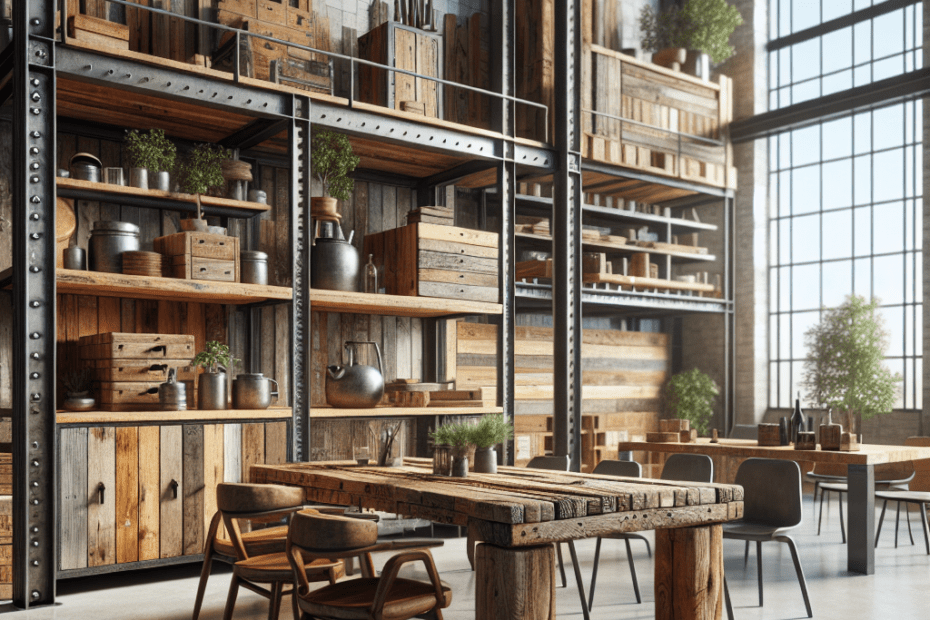“`html
The Role of Reclaimed Wood in Industrial Design
The role of reclaimed wood in design has been growing in popularity as conservation and sustainability become critical in mitigating climate change. Designers harness the natural beauty and unique character of reclaimed wood, recognizing it as a vital component in contemporary industrial design. Reclaimed wood not only contributes to eco-friendly practices but also adds a rich history and character to interior spaces.
The Aesthetic Appeal of Reclaimed Wood
Reclaimed wood brings with it a distinct aesthetic quality that new wood simply can’t offer. Its weathered appearance, with dents, nail holes, and a varied patina, tells a story of its past life, which can be decades, or even a century old. This unique charm is a primary reason why reclaimed wood is favored in industrial design. Designers love that no two pieces are exactly alike, offering endless possibilities to create one-of-a-kind items.
Sustainability and Environmental Benefits
One of the key reasons for the increasing use of reclaimed wood in design is its sustainability. Utilizing reclaimed wood helps reduce the demand for newly-harvested timber, thereby conserving forests. According to the USDA Forest Service, U.S. forests sequester around 14% of the country’s total carbon dioxide emissions annually. By choosing reclaimed over new, they directly support forest conservation efforts.
Applications in Industrial Design
Reclaimed wood is incredibly versatile and is used in numerous applications within industrial design. From flooring to furniture and decorative wall claddings, its applications are vast. Its structure adds warmth to spaces and creates a contrast with industrial materials like metal and concrete, often used in modern designs. The combination of elements can be stunningly innovative.
Challenges in Using Reclaimed Wood
While there are clear advantages, there are also certain challenges associated with using reclaimed wood. Identifying true reclaimed wood can be difficult, requiring designers and consumers to research suppliers. Proper treatment and processing are essential to ensure the wood is free from pests and safe for indoor use. Despite these challenges, the benefits often outweigh the difficulties when done correctly.
Reclaimed Wood and Modern Design Trends
The marriage of reclaimed wood with modern design trends brings forth a blend of old and new that is often celebrated in industrial design. As spaces evolve to embody openness and functionality, the warmth and texture of reclaimed wood offset more sterile elements like steel and glass. This makes it a staple in modern applications.
| Application | Purpose |
|---|---|
| Flooring | Provides rustic charm and historical depth to spaces. |
| Furniture | Creates unique, durable pieces with aesthetic interest. |
| Wall Cladding | Adds texture and a natural element to industrial spaces. |
The Future of Reclaimed Wood in Design
With increasing environmental awareness, the future of reclaimed wood in design looks promising. As they continue to seek sustainable solutions, the demand for reclaimed materials is likely to grow. According to a study by the Global Wellness Institute, the global wellness economy, including eco-friendly home building, is predicted to grow by 5%-10% annually, indicating a rising consumer interest in sustainable materials.
Key Takeaways
- Reclaimed wood offers unmatched character and history to industrial design.
- Utilizing reclaimed wood supports sustainability by conserving forests.
- Its versatility makes it suitable for various applications such as flooring, furniture, and wall cladding.
- Challenges such as sourcing and treatment exist, but the benefits prevail.
- The trend of reclaimed wood in modern design continues to rise, reflecting an increased focus on sustainable design practices.
FAQ
- What is reclaimed wood?
- Why is reclaimed wood popular in industrial design?
- Is reclaimed wood more expensive than new wood?
- How can they ensure reclaimed wood is safe for use in their home?
- Can reclaimed wood be used in any design style?
Reclaimed wood is wood that has been salvaged from old buildings, barns, or other structures and reused in new construction or design projects.
It is popular for its unique appearance, historical significance, and environmental benefits, contributing to sustainable design practices.
Reclaimed wood can be more expensive due to the labor involved in sourcing and processing it, but its unique aesthetic and eco-friendly benefits can justify the cost.
They should purchase from reputable suppliers who properly treat the wood to eliminate pests and ensure it’s safe for indoor use.
Yes, while commonly associated with rustic or industrial styles, reclaimed wood can complement a wide range of design styles due to its versatile nature.
“`
